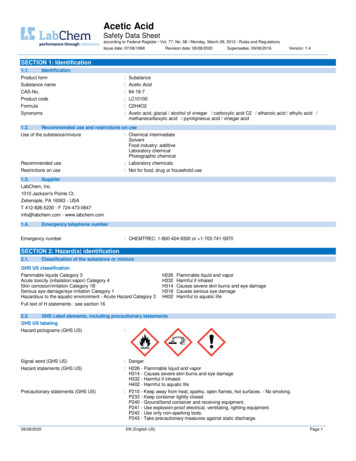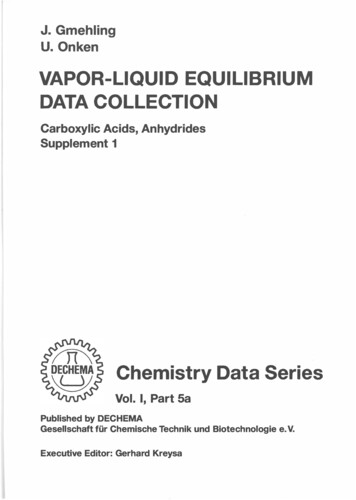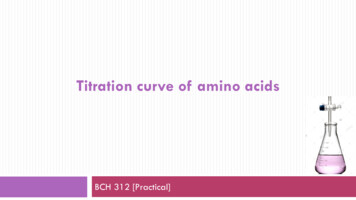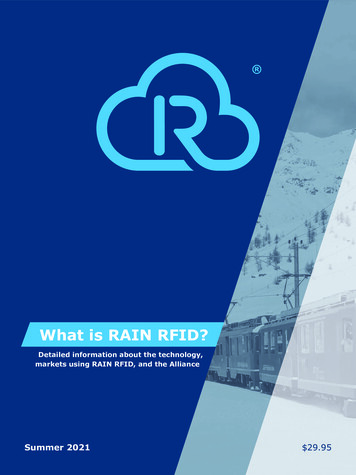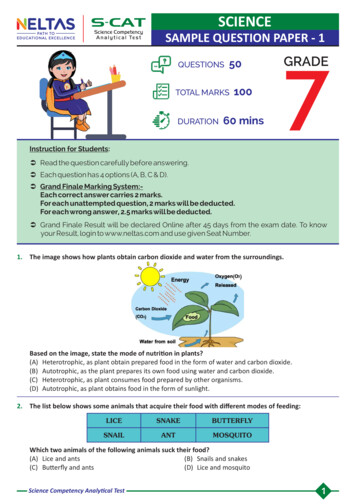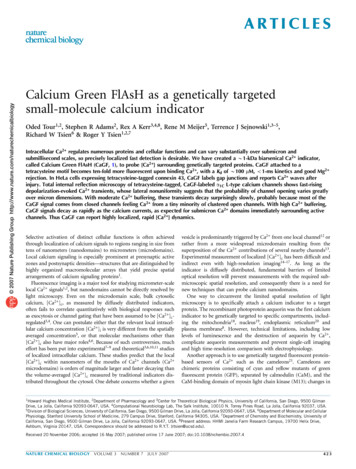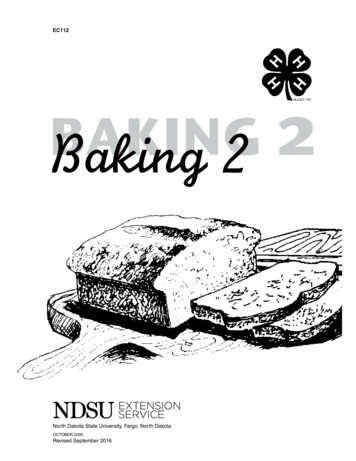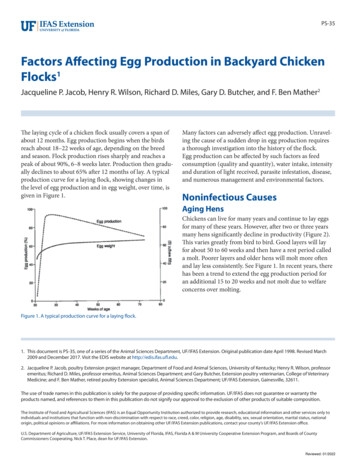
Transcription
Acid Rain Impacts on CalciumNutrition and Forest HealthAlteration of membrane-associated calcium leads t o membranedestabilization and foliar injury in red spruceDonald H. DeHayes, Paul G. Schaberg, Gary J. Hawley, and G. Richard Strimbeckorest ecosystems throughoutthe world are exposed to acidrain, a complex solution consisting largely of- H , SO,"-, NH, ,and NO,- pollutant ions derived fromsulfur and nitrogen oxides. Althoughthe public in the United States mayview acid deposition as a localizedpollution issue specific to certain regions of North kmerica and northern Europe, recent evidence of acidicdeposition throughout much of Asia,including tropical forest regions, hasdemonstrated that acid deposition isactually a global phenomenon (Abate1995).Furthermore, despite downwardtrends in sulfate concentrations associated with reductions in sulfurdioxide emissions mandated by the1990 Clean Air Act Amendments,the acidity- of precipitation in easternNorth America dies not seem to bedecreasing (Scherbatskoy et al. inpress). For example, over the courseof 1 0 fog event; on the summit ofMt. Mansfield, Vermont (elevation1237 m), during summer 1998, thecloud water had an average pH of2.8, with several events of pH 2.1-The stress responsesystem and overall healthof montane coniferousforest ecosystems may becompromised by a subtlebut persistent acidinduced alteration ofmembrane-associatedcalcium2.5 (Sean Lawson and TimothyScherbatskoy, personal communication, data on file at the School ofNatural Resources, The Universityof Vermont). The median and minimum cloud water p H values fromMt. Mansfield are more acidic thancomparable summer measurementsmade on nearby Whiteface Mountain, New York (elevation 1483 m),from 1982 to 1987 ( p H 3.4-3.8;Mohnen 1992). These findings colDonald H. DeHayes (ddehayes@nature. lectively highlight the severity ofsnr.uvm.edu) is a-professor gnd interim cloud water acidity engulfing mondean, Gary J. Hawley (e-mail: ghawley@ tane forests in the eastern Unitednature.snr.uvm.edu) is a senior researcher, States and the ongoing nature of acidand G. Richard Strimbeck (e-mail: deposition. The prevalence and pergstrimbeck@nature.snr.uvm.edu) is an sistence of acid deposition has fueledadjunct lecturer at the School of NaturalResources, The University of Vermont, public concern about the widespreadBurlington, VT 05405. Paul G. Schaberg impact of acid rain on forest health.It is now well documented that(e-mail: pschaberg@aol.com) is a researchplant physiologist at Northeastern Re- anthropogenic changes in precipitasearch Station, USDA Forest Service, South tion chemistry and acidity have ocBurlington, VT 05403.curred over the past several decadesOctober 1999in North America. In addition, aciddeposition-induced leaching, depletion, and cycling disruption of calcium in forest soils has recently beendemonstrated (Lawrence et al. 1995,Likens et al. 1996, 1998). Cumulative estimates show that, as a resultof acid deposition, the pool of calcium in the soil complex may haveshrunk by as much as 50% duringthe past 45 years (Likens et al. 1996),a reduction that may have long-termimplications even if the acidity ofprecipitation begins to ameliorateover time. Despite these well-documented and substantial physicalchanges, the extent and nature of theimpact of these belowground changeson forest ecosystem health has beenuncertain or only speculative. TheNational Acid Precipitation Assessment Program (NAPAP), in its 1992Report to Congress (NAPAP 1992),declared that "there remains no evidence of a general, widespread decline of forest tree species caused byacidic deposition." However, thereport did conclude that "acidicdeposition has been firmly implicatedas a causal factor in northeasternhigh-elevation red spruce decline"(NAPAP 1992).Indeed, numerous field and laboratory studies have demonstrated thatred spruce (Picea rubens) has sufferedwidespread freezing injury (Peart et al.1991, DeHayes 1992), growth reductions (Cook and Zedaker 1992), andmortality (Johnson et al. 1986,1992,1996) over the past 40 years. Thecause(s) of enhanced freezing injuryand decline of red spruce, includingthe possible influence of air pollution,789
Table 1. Estimates of midwinter cold tolerance for current-year foliage of red spruce from northern US populations.LocationDateWhiteface Mountain, NYUpper Jay, NYNesowdnahunk Lake, MECamel's Hump Mountain, VTMt. Mansfield, VTMt. Mansfield, VTJanuaryJanuaryJanuaryJanuaryJanuaryJanuaryNumber of trees1987198819901992199519962091051060Injury temperature ("C)" ReferenceLTlo -37bT, -42T, -41bLT,, -44bT, -47T, -42Sheppard et al. 1989DeHayes 1992Hadley and Amundson 1992Perkins et al. 1993Strimbeck et al. 1995Schaberg et al. in press aaLTlo,20is the temperature associated with 1 0 % or 20% foliar freezing injury, T, is the highest temperature at which statistically significantincrease in freezing injury is detected, and T, is the temperature associated with the increase in slope of the injury response curve.bEstimated from Sheppard et al. 1989.were a major focus of NAPAP's ForestResponse Program and have been studied intensively in both North Americaand Europe. Red spruce decline has,in fact, become synonymous withacid rain throughout much of theNorthern Hemisphere.Despite this general association,an empirically based physiologicalunderstanding of and explanationfor red spruce decline have not beenestablished. Several potential broadbased explanations have been proposed. For instance, perturbation ofcalcium nutrition has been identifiedas a potential stress factor contributing to red spruce decline (Shortle andSmith 1988, McLaughlin et a1.1993,Lawrence et al. 1995). Specifically,it has been proposed that aluminumthat is mobilized in mineral soil byacid deposition reduces soil storageof calcium and its availability forroot uptake (Shortle and Smith 1988,Bondietti et al. 1990, Lawrence et al.1995). The resulting calcium deficiencies might be expected to lead tothe reductions in Ca:Al ratios, sapwood area, and live crown volumesthat are evident in some red sprucetrees (Shortle and Smith 1988),leaving trees more vulnerable to secondary stresses, such as diseases, insectpests, and freezing stress. Acid-inducedreductions in foliar calcium concentrations of red spruce in the southernAppalachians have also been linkedto increases in dark respiration andreductions in net photosynthesis,which could also contribute to decline symptoms (McLaughlin et al.1991, 1993). An alternative explanation for the effects of acid rain onred spruce (Sheppard 1994) holdsthat exposure of trees to elevatedSO:- in acid rain may alter carbonmetabolism of trees by consumingenergy associated with sequesteringS0,2-ions and repairing injury that a790buildup of these ions might cause tomembrane proteins. The "cost" ofsuch carbon allocation is expected tobe physiological impairment and increased vulnerability to secondarystresses, including freezing stress.Whatever the mechanism for redspruce decline, a strong direct linkbetween freezing injury and red sprucedecline has been established in northern montane regions of the red sprucegeographic range (DeHayes et al.1990, DeHayes 1992, Johnson et al.1996). The link is so strong that redspruce decline is actually attributedto freezing injury in northern regions (Wilkinson 1990, Tobi et al.1995). Freezing injury results in aloss of foliage critical for photosynthate production and storage, and itleads to the reduced basal area, heightgrowth, and live crown volume typical of the red spruce decline syndrome (Wilkinson 1990, DeHayes1992, Tobi et al. 1995). Historicalevidence and analysis indicate thatthe frequency of freezing injury episodes in red spruce forests has increased over the past 40 years (Friedland et al. 1984, DeHayes 1992,Johnson et al. 1992, 1996), a periodthat coincides with increased emissions of sulfur and nitrogen oxidesand acid deposition.Although much has been learnedabout the ecology and decline of redspruce (e.g., Barnard et al. 1990,Eagar and Adams 1992, NAPAP1992, Johnson et al. 1996), including freezing injury symptomologyand pathology, a clear understanding of the physiological and environmental causes of freezing injury inred spruce has not emerged. In particular, an empirically supportedmechanism that explains how acidrain might enhance freezing injurysusceptibility and lead to the deterioration of forest health has beenlacking. In this article, we synthesizeexisting and new information thatdemonstrates acid rain alteration ofthe foliar calcium pool specificallyassociated with the plasma membrane-cell wall compartment in redspruce mesophyll cells. In addition,we provide direct evidence that linksthis physiological disruption to redspruce freezing injury and declinethroughout eastern North America.Finally, we consider the acid-inducedalteration of this particular physiologically important pool of calciumin the context of other hypothesesfor red spruce decline and discuss thebroad implications of alteration ofthe foliar calcium pool to foresthealth and well-documented soil calcium depletion.Freezing injury to red spruceDespite early reports of "winter drying" or "desiccation" as causes ofthe foliar dieback referred to as "winter injury" in red spruce (Curry andChurch 1952, Pomerleau 1962,Morgenstern 1969), it is now wellestablished that red spruce winter injury is caused by subfreezing temperatures (Strimbeck et al. 1991, Perkinset al. 1991, DeHayes 1992). Redspruce has been subjected to repeated,severe, regionwide freezing injury formany decades. In recent years, majorregionwide freezing injury eventshave occurred at approximately 4year intervals on average, with moderate, more localized injury occurring in intervening years.Numerous cold tolerance assessments of red spruce have been conducted over the past decade. Despitevarying procedures and sampling ofdifferent northern montane populations, a remarkably consistent patternof midwinter maximum cold tolerance for red spruce has emerged.BioScience VoE. 49 No. 10
Laboratory studies indicate that theaverage temperature at which current-year needles of red spruce innarthern New England and NewYork undergo freezing injury is inthe range of -37 "C to -47 "C (Table1). Because controlled freezing environments are thought to be less stressful than natural conditions (Hadleyet al. 1996, Schaberg and DeHayesin press), these laboratory freezingstudies probably overestimate thecold tolerance of red spruce.The most comprehensive assessment of cold tolerance in red spruce,which examined the January coldtolerance of 60 native red sprucetrees across an elevational range onMt. Mansfield, revealed an averageinjury temperature of -41.7 "C and arange of -30 "C to -54 "C (Figure 1;Schaberg et al. in press a). A significant fraction of the trees (36%)wereinjured at temperatures warmer than-39 "C (Schaberg et al. in press a).Analysis of climatic records fromMt. Mansfield over the past 44 yearsindicates that temperatures rarely getas low as -40 "C but that they dropto as low as -35 "C and -30 "C inapproximately 30 % and 9 1% of winters, respectively (Figure 1). Thus,during most winters in northernmontane habitats, ambient temperatures approach the maximum coldtolerance of at least some red sprucetrees, accentuating the unique susceptibility of red spruce to freezinginjury. Most northern coniferous species, by contrast, have winter coldtolerance levels well beyond minimumambient temperatures (DeHayes1992). Freezing injury susceptibilityis greater for red spruce than sympatric species, such as balsam fir (Abiesbalsamea).Freezing injury susceptibility ofred spruce is almost always limitedto current-year foliage, which is approximately 1 0 "C less tolerant offreezing in winter than year-old foliage (DeHayes et al. 1990, DeHayes1992).The difference in freezing tolerance between young and olderneedles indicates that red spruce hasthe physiological capacity to developgreater cold tolerance. In fact, if current-year needles of red spruce wereequal in cold tolerance to year-oldneedles, then the species would escape freezing injury in all but themost severe winters. Considering theOctober 1999Figure 1. Winter ternpeiatures and cold tolerance on Mt. Mansfield. (a) Cumulativefrequenciesof minimumwinter temperatures at1200 m elevation overa 44-year period. (b)Midwinter cold tolerance of 60 native redspruce trees (Schaberget al. in press a). 120,aI100-g 91% of winters*O-h3 5 60.g 59 4030% of winters 0. 20-49% of winters40.-55.,-50-.--I.-45.-40-35-30Ambient temperature (OC)marginal cold toleranceof current-year.follage, any envlronmental disturbance,such as acid rain,that might reduce thecold tolerance of foliage by just a fewdegrees would be expected to result in adramatic increase inthe frequency of freezing injury.4 .108;z2oAcid rain andtoleranceConsiderable research has, in fact,established that exposure of redspruce foliage t o both simulated(Fowler et al. 1989, L'Hirondelle etal. 1992, Waite et al. 1994) andambient (DeHayes et al. 1991, Vannet al. 1992) acidic cloud water reduces the cold tolerance of currentyear foliage. Experiments that wehave conducted over several yearsunder both laboratory and field conditions and involving mature trees aswell as seedlings have consistentlydocumented that exposure to acidicmist reduces the midwinter freezingtolerance of red spruce trees by 3-1 0"C (Schaberg and DeHayes in press).Cold tolerance reductions of thismagnitude are sufficient to explainthe widespread freezing injury to redspruce observed in northern montane forests over the past 40 years(DeHayes 1992, Johnson et al. 1996).That is, if seasons of high acid deposition loading reduced red sprucecold tolerance by an average of 6-7"C, then the reduction in averagecold tolerance-from -41.7 "C toapproximately -35 "C-would be expected to lead to freezing injury underambient conditions approximately every 4 years on Mt. Mansfield (FigureCold tolerance ("C)1).Acid deposition in the p H rangecurrently experienced would be especially problematic for northernmontane red spruce trees on the lowend of the cold tolerance range (i.e.,36% of the red spruce trees on Mt.Mansfield).Potential involvementof foliar calciumT o examine how atmospheric pollution has led to enhanced freezinginjury and the consequent decline ofred spruce forests, we have studiedthe physiology of red spruce's response to acid deposition. In particular, we have examined acid mistinduced alterations in calciumphysiology as a potential mechanismfor low-temperature injury in redspruce foliage. Calcium is an abundant element in trees and a majorcation in soil and surface waters.Acid deposition has a substantial andpotentially long-lasting influence onleaching, depletion, and cycling ofcalcium in forest soils (Shortle andSmith 1988, Lawrence et al. 1995,Likens et al. 1996). Such findingshighlight the belowground and atmospheric implications of base cat79 1
- 50I1Ca deficiency range- 200III200400600800 pg/g deficiency threshold (Swan 1971)IIII800Normal range of foliar CaIIIIIII\I1000 1200 1400 1600 1800 2000 2200 2400 2600Total foliar Ca concentration (pg/g)Figure 2. Relationships between foliar calcium concentration and midwinter coldtolerance for 30-year-old red spruce trees in northwestern New Hampshire thatexhibit foliar calcium deficiency (less than 800 pglg; Swan 1971) or are within thenormal range of foliar calcium (Schaberg and DeHayes in press).ion depletion and altered nutrientcycling. They also raise the possibility that acid deposition might haveprofound effects on calcium physiology of trees and overall forest health.The potential effects of a reductionin calcium reserves are especially iptriguing for red spruce, the one NorthAmerican tree species whose declinehas been firmly linked to inputs of1800-1acid deposition (NAPAP 1992).Empirical information has demonstrated that red spruce trees withvery low foliar calcium concentrations are less cold tolerant than treeswhose foliar calcium levels fall in thenormal range (Figure 2; Schabergand DeHayes in press). In fact, thereis a strong and significant positiveassociation between cold toleranceIResistant- - - - - - - - Susceptible.IIcurrent- 1I600 -1IIIIIISeptember October November December JanuaryIFebruaryIbhIIAprilMayJuneJulyAugustSample dateFigure 3. Relationships between foliar calcium concentration and freezing injury forcurrent-year and year-old foliage of red spruce trees in northwestern New Hampshirewith histories of susceptibility or resistance (Wilkinson 1990) to freezing injury (DonaldH. DeHayes, Paul G. Schaberg, Gary J. Hawley, George R. Strimbeck, unpublished data).792and foliar calcium for trees exhibiting foliar calcium deficiency, whereasthese parameters appear to be unrelated at higher calcium concentrations (Figure 2). Among 30-year-oldred spruce trees growing in a lowcalcium soil in northern New Hampshire, those trees that were consistentl; susceptible to freezing injuryhad significantly lower foliar calcium concentrations in current-year,but not year-old, foliage than frostresistant trees (Figure 3; Donald H.DeHayes, Paul G. Schaberg, Gary J.Hawley, George R. Strimbeck, unpublished data). Furthermore, experimental work has documentedthat acid mist induces foliar calciumleaching (Joslin et al. 1988, DeHayeset al. 1991, McLaughlin et al. 1996,Schaberg et al. in press b). Acidinduced calcium deficiency has alsobeen proposed to cause dark respiration increases and altered carbon metabolism associated with red sprucedecline in the southern AppalachianMountains, where freezing injury isnot a problem (McLaughlin et al.1990, 1991, 1993).Acid-induced foliar leaching and coldtolerance reductions. Exposing redspruce trees to simulated acid miststhat consisted of a base solution withan ionic composition patterned afterregional cloud chemistry and realistic acidic p H levels (Schaberg andDeHayes in press) consistently demonstrated that calcium leaching fromcurrent-year needles during autumn(Figure 4a) was significantly greaterin response to p H 3.0 than to p H 5.0mist additions. Calcium concentrations were 2-10 times greater inleachates of foliage exposed to themore acidic mist. An in vitro experiment designed to partition the sourceof leached calcium showed that most(approximately 85%) of the acidleached calcium was derived fromneedles rather than stems and thatnearly 5 0 % more calcium wasleached from current-year foliagethan from year-old foliage (Figure 5;Schaberg and DeHayes in press).Analysis of leachate also indicatedthat p H 3.0-treated foliage assimilated nearly 60 times more H thanp H 5.0-treated needles. Furthermore, acid mist-induced calciumlosses were accompanied by significantly greater membrane disruptionBioScience Vol. 49 No. 2 0
(Figure 4c) and a 4-10 "C reductionin freezing tolerance at pH 3.0 thanat p H 5.0 during late autumn andwinter subsequent to acid mist exposure (Figure 4d). This result indicates that acid mist has a direct negative impact on membrane stabilityindependent of low temperature, andit po-ints to the plasma membrane asthe potential site of acid-inducedcalcium disruption.Importance of membrane-associatedcalcium. Although there were up to10-fold differences in foliar calciumleaching between p H treatments, wehave not detected a reduction in total calcium pools in foliage treatedwith simulated acid mists that mimicambient p H levels and amounts (Figure 4b). However, calcium withincells and tissues is highly compartmentalized, and this partitioning iscritical to its physiological functionin plants. The majority of the calcium in coniferisextracellularoxalate andpectatewhich are of littlephysiologicalimportance (Fink 1991).In contrast, the labile calcium ionsin equilibrium within the plasmamembrane region (including somefreely displaced apoplastic calciumfrom the cell wall) are of major physiological importance. This pool ofmembrane-associated Ca (mCa), although a relatively small fraction oftotal foliar ion pools, strongly influences the response of cells to changing environmental conditions (Heplerand Wayne 1985, Dhindsa et al.1993, Monroy et al. 1993, Sheen1996). Because total foliar calciumestimates primarily reflect the dominant insoluble and immobile extracellular calcium pool, these estimatesmay mask relatively subtle, but critical, shifts in the labile and environmentally sensitive mCa pool. Indeed,recent experiments have demonstrated the relative seasonal stabilityof total foliar calcium pools compared with mCa and the lack of association between mCa and total foliarcalcium pools (Figure 6; DeHayes etal. 1997).In fact, foliar calcium concentrations are not an accurate indicator of relative levels of mCa, especially for trees whose calciumconcentrations fall within the normal range (Swan 1971).The plasma membrane of plantsOctober 1999(a -n0.80.6-bJ203U0.0)o.4.?X0.3-3 32O C 93NOV93Nov 93Feb 94Nov 93Feb 94Nov 93Feb 9432g"40-22 ;. 20.12oSample dateSample dateFigure 4. Impacts of acid mist treatment on physiological properties of red spruce.Open bars, p H 3.0; solid bars, p H 5.0. (a) In vivo calcium leaching. (b)Total foliarcalcium. ( c ) Membrane stability as measured by cellular electrolyte loss. (d) Coldtolerance from red spruce foliage (Schaberg and DeHayes in press). Treatmentmeans are either not significantly different (ns) or are significantly different atP I0.05 ( * ) based on analyses of variance.plays a critical role in mediating coldacclimation and low-temperatureinjury (Pomeroy and Andrews 1985,Steponkus 1990). Membrane architecture influences solution movementacross membranes and the ability ofcells to resist dehydration, extracellular ice damage, and, perhaps, intracellular freezing during cold acclimation (Arora and Palta 1986,1988, Guy 1990). Membrane-associated calcium influences plasmamembrane structure and function,stabilizing membranes and influencing permeability by bridging phosphate and carboxylate groups ofmembrane phospholipids and proteins(Figure 7; Palta and Li 1978, Legge etal. 1982, Davies and Monk-Talbot1990).Thus, mCa influences cold tolerance, at least in part, through itseffects on membrane structure.The labile mCa pool (Atkinson etal. 1990) also serves an importantrole as a second messenger in theperception and transduction of environmental signals, including low temperature (Figure 7; Hepler and Wayne1985, Dhindsa et al. 1993, Monroyet al. 1993, Sheen 1996). Thus, lowtemperatures may trigger mCa transport across the plasma membraneinto the cytoplasm, where calciuminteracts with biomolecules that helpregulate physiological responses tofreezing stress.Seasonal changes in mCa. In addition to the considerable documentaFigure 5. Influence of pH 3.0 and pH 5.0mists on in vitro calcium leaching of needlesof red spruce seedlings. CY, current-yearneedles; YO, year-old needles; open bars,needles plus twigs; solid bars, needles alone(Schaberg and DeHayes in press).Tissue age class793
0-010002000300040005000600070008000Total foliar Ca concentration (pglg)Figure 6. Relationship between total calcium and membrane-associated calcium(mCa) concentrations for current-year foliage of red spruce seedlings (DeHayes etal. 1997). Parameters are not significantly correlated (r -0.14, P 0.34).tion of calcium's general role in plantcold hardiness physiology, additionalempirical data specifically implicatemCa involvement in the developmental cold tolerance of red spruce. Unlike total foliar calcium pools, mCapools in current-year, but not yearold, needles are seasonally dynamicand responsive to temporal environmental changes that parallel seasonalchanges in membrane structure related to cold acclimation. For example, late summer-early autumnincreases of mCa in current-yearneedles (Figure 8; DeHayes et al.1997) may reflect an increase in calcium ion exchange sites associatedwith short day-induced increases inmembrane phospholipids, whereasapparent frost-initiated reductions inmCa are most likely associated withchanges in the fatty acid compositionof membrane lipids (DeHayes et al.1997) and perhaps with a role formCa in the perception and transduction of the low-temperature cold acclimation signal (Arora and Palta1986,1988, Guy 1990).We have also documented abrupt,albeit temporary, reductions in mCa(Figure 8; DeHayes et al. 1997) andfreezing tolerance (Strimbeck et al.1995)in red spruce current-year, butnot year-old, needles in response to amidwinter thaw. After the thaw, bothmCa and freezing tolerance returnedto pre-thaw levels. Sequential changesin mCa and cold tolerance levels, to-gether with the well-documentedchanges in membrane structure inleaf tissue of north temperate conifers during cold acclimation (DeYoeand Brown 1979, Senser and Beck1982), strongly support the contention that mCa is important to coldtolerance. Consequently, if acid mistreduces mCa through calcium leaching, then an alteration in membranefunction, low-temperature signaltransduction, and freezing injury susceptibility (and perhaps sensitivity to otherstressors) would likely follow.Perturbations to mCa versus totalfoliar calcium pools. Efforts to understand the physiological role ofcalcium in the reduced cold tolerance of acid mist-exposed red sprucewere previously impeded by the difficulty of generating meaningful measures of the critical mCa compartment of the total foliar calcium pool.We have now developed and tested aprotocol for measuring mCa inwoody plant tissue (Borer et al. 1997)and have used it to evaluate the impact of acid mist and soil solutionchemistry on red spruce physiologyand nutrition (Schaberg et al. in pressb). We examined freezing tolerance,mCa, total foliar calcium, and foliarcalcium leaching of red spruce treesgrown in a sandlperlite soil selectedfor its low pretreatment calcium content (52 pglg; Schaberg et al. in pressb). Plants were exposed in a factorialarrangement to three treatments expected to result in biological calciumperturbation: soil solution calciumadditions (0,25,75, or 225 pmol1L);soil solution aluminum ( 0 or 200pmolIL), which can compete withand inhibit calcium uptake by roots(Shortle and Smith 1988); and pH 3.0or pH 5.0 mist, which caises dl;fferential calcium leaching (Schaberg et al.in press b).Soil calcium additions enhancedtotal foliar calcium concentrationsand increased rates of respirationduring the early growing season(Schaberg et al. in press b). As expected, soil aluminum treatment inhibited the incorporation of calciumand other cations, altered foliar gasexchange throughout the g o w i n gseason, and reduced growth. Calcium additions increased foliar calcium incorporation but did not otherwise alter aluminum treatmenteffects; thus, the aluminum-inducedchanges in physiology appear to bedirect and independent of foliar calcium nutrition. Neither calcium noraluminum soil treatments had anydiscernible impact on foliar calciumleaching, mCa levels, or freezcng tolerance,- which implies that belowground manipulations of soil andfoliar calcium pools may not havei m p o r t a n t physiological conseauences for red sDruce trees.In contrast to the soil treatments,acid mist treatments had profoundphysiological effects. compared tothe pH 5.0 mist treatment, p H 3.0mist applied to the entire plant, inin summer and early' cluding soil,autumn resulted in foliar calciumleaching and in consistent, significant, and parallel reductions in latefall and winter freezing toleranceand mCa levels of cirrent-yearneedles (Table 2). Acid mist-inducedreductions in mesophyll cell mCawere relatively mino; in late summerbut reached a maximum of 35% between mist treatments by midwinter(Table 2), even though acid mist treatment had been removed months earlier. A similar pattern was evidentfor the acid mist influence on coldtolerance (Table 2).Although soil calcium and aluminum manipulations influenced calcium nutrition and physiology, thesesoil-driven reactions alone did notenhance foliar calcium leaching, alIIBioScience Vol. 49 No. 10
ter mCa, or reduce freezing tolerance, which appear to be criticalprecursors to red spruce decline innorthern montane forests. Changesin foliar calcium from soil treatmentsprobably reflected alterations inextracellular calcium pools (e.g., theconcentration of calcium oxalate crystals in cell walls) that have low physiological availability. Changes in mCafrom direct acid mist application tofoliage, by contrast, reflected enhanced calcium leaching, leading tomembrane instability and, perhaps,to disruption of calcium's role inenvironmental signal transduction.The pronounced differences incold tolerance and susceptibility tofreezing injury in red spruce needlesof different ages (DeHayes 1992) isconsistent with the pattern of developmental variation in mCa in current-year needles (Figure 8) as wellas age class differences in foliar calcium leaching (Figure 5). Even without acidic inputs, little or no mCa isdetected in current-year needles ofred spruce during early summer (Figure 8). Moreover, mCa levels in current-year needles are inherently lowerthan in year-old needles throughoutsummer and early autumn (Figure8),when acid-induced calcium leaching is expected to be substantial. Thesubstantial age class difference infoliar calcium leaching (Figure 5 )further accentuates the mCa and coldtolerance differences between yearold and current-year red spruceneedles, helping to explain the uniquelow-temperature sensitivity of redspruce current-year foliage.The magnitude and persistence ofthe acid mist influence on mCa andcold tolerance throughout winter andthe responsiveness to short-term acidmist applications in autumn are mostlikely a function of the amount ofcalcium leached, the lack of mobilityof calcium in the phloe
cloud water had an average pH of 2.8, with several events of pH 2.1- Donald H. DeHayes (ddehayes@nature. snr.uvm.edu) is a-professor gnd interim dean, Gary J. Hawley (e-mail: ghawley@ nature.snr.uvm.edu) is a senior researcher, and G. Richard Strimbeck (e-mail: gstrimbeck@nature.snr.uvm.edu) is an adjunct lecturer at the School of Natural
